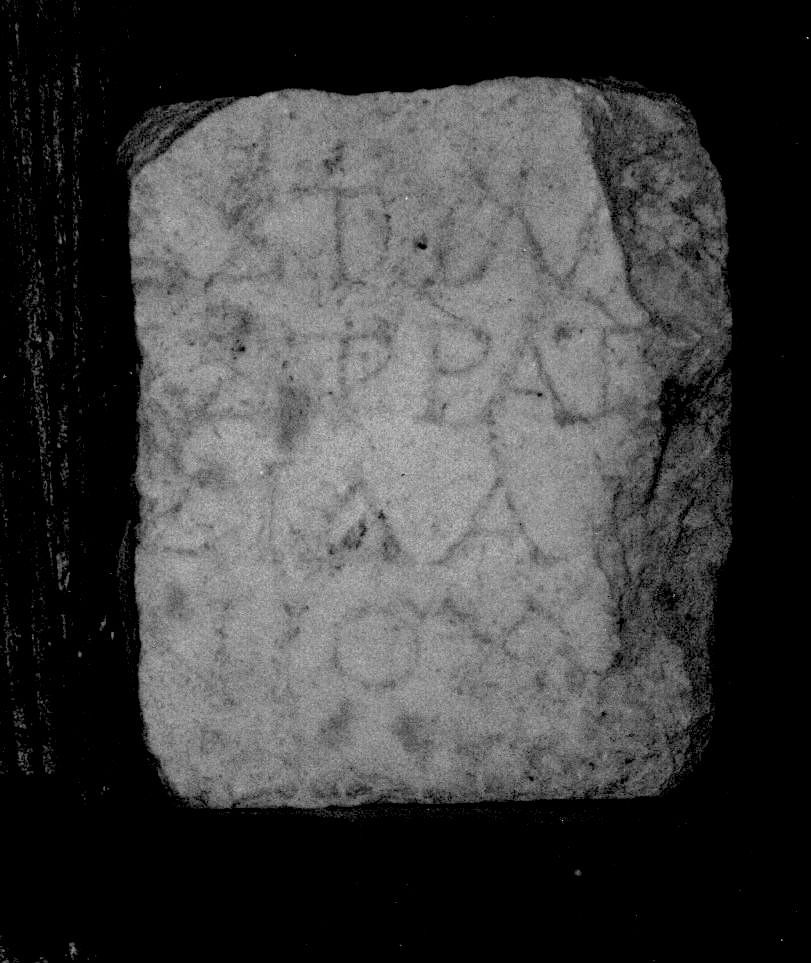EpiDoc XML:
IGCyr1384002
Trismegistos ID:
997646
Source description
Support: Fragment of a white marble panel broken off at right, probably re-cut at left and bottom and slightly chipped off on those edges (preserved dimensions w: 0.09 × h: 0.10 × d: 0.03).
Layout: Inscribed on the face, beginning at 0.017 from the upper edge.
Letters: Very carefully and not very deeply cut letters (0.015, interline space 0.007) with light serifs; alpha with rather low bar, some sigmas still slightly slanting.
Date: Probably second half of third century BC (lettering).
Findspot: Found plausibly after World War II at Cyrene ➚, exact findspot not registered.
Place of origin: Findspot.
Last recorded location: Cyrene Museum, 1812. Seen in 2001 by Dobias-Lalou in Shahat: Cyrene Museum.
Text constituted from: Transcription from stone (CDL).
Bibliography
Never published before this edition.
Text
Apparatus
2: [c. 1 - 3]υ̣στράτω̣: [Ε]ὐ̣στράτω̣ or [Λεβ]υ̣στράτω̣
French translation
[Un tel] (scil. fils d')Astyllos, [Un tel] (scil. fils de) [---]ystratos, [Un tel] (scil. fils de) [---]eidas, [Un tel] (scil. fils d')Haniokhos, [Un tel] (scil. fils d')Andronikos, [---].
English translation
[So and so] (scil. son of) Astyllos, [So and so] (scil. son of) [---]ystratos, [So and so] (scil. son of) [---]eidas, [So and so] (scil. son of) Haniochos, [So and so] (scil. son of) Andronikos, [---].
Italian translation
[Il tale] (scil. figlio di) Astyllos, [Il tale] (scil. figlio di) [---]ystratos, [Il tale] (scil. figlio di) [---]eidas, [Il tale] (scil. figlio di) Haniochos, [Il tale] (scil. figlio di) Andronikos, [---].
Commentary
This very carefully cut inscription lists names at the genitive case, thus fathers' names. Amongst them, Haniochos is very common and typical of Cyrenaica. Astyllos is already attested only once (IGCyr0652002 a.i.54), with a lost father's name, at the beginning of the same century. For the name at line 2, amongst the possible restorations, three are favourite: Εὔστρατος, which is the name of a military officer about 335 BC (IGCyr0840002 b.1.88); Πολύστρατος, of which the short form Πόλυστρις is a priest's name in IGCyr1150002 i.36, in the second half of the third century BC; or Λι/εβύστρατος, a local name attested on coins and also attested twice in a lost context dated into the fourth century BC (IGCyr0803002 a.2 and IGCyr0971002 a.27). As for Andronikos, it is attested only once at the end of the second century BC (IGCyr1150002 ii.25). We can only conclude that the men listed here belonged to the upper class of the Hellenistic Cyrene.
CC BY-NC-SA 4.0 Deed Attribution-NonCommercial-ShareAlike 4.0 International License.
All citation, reuse or distribution of this work must contain a link back to DOI: https://doi.org/10.60760/unibo/igcyrgvcyr2 and the filename (IGCyr000000 or GVCyr000), as well as the year of consultation.

